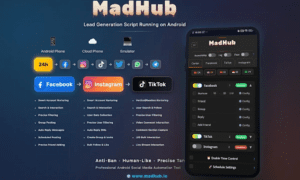CTOs and Engineering Managers are under constant pressure to align engineering with business goals – cutting cloud costs, speeding up release cycles, and keeping applications responsive. That means making sure software is not just functional, but fast, scalable, and efficient. .NET remains the backbone for many enterprise systems across various domains, from e-commerce and finance to healthcare and IoT. When .NET apps run better, the entire business does too: fewer slowdowns, better UX, more reliability where it counts. With .NET 8/9/10 rolling out, and modern cloud/hardware architectures shifting fast, yesterday’s tuning tricks may no longer apply. What worked in 2022 might cost you in 2025. This guide focuses on updated, forward-looking performance strategies – practical ways to reduce technical debt, improve system behavior, and future-proof your .NET applications.
Dmitry Baraishuk, the Chief Innovation Officer (CINO) of a custom software development firm Belitsoft, shares his expertise in .NET development projects. The company has been delivering .NET solutions for 20+ years in various domains from finance and retail to healthcare and government. The agency proved its reputation with a 4,9/5 score from client reviews on the most authoritative platforms like Gartner, G2, and Goodfirms. Belitsoft’s senior .NET software engineers create real-time apps and web pages by applying the ASP.NET Core extension, provide REST API development services, build microservices, and modernize the current .NET-based software to boost its performance.
The Profile-Optimize-Measure Cycle
First, you profile – under load, in conditions that reflect how the system actually behaves. Not idealized staging. Not “on my machine”. You measure what’s slow, what’s expensive. Only then do you touch the code.
When the fix goes in, you measure again. Same tool. Same method. If it’s faster, you keep it. If it’s not, you revert.
This loop keeps performance grounded in reality. It prevents the classic trap: engineers spending days on optimizations that move the wrong metric – or no metric at all.
The compounding effect is – fewer regressions, leaner infrastructure, apps run faster, scale more predictably, and cost less to operate, customer-facing issues shrink. So does the risk of overprovisioning.
First – Architecture, Then – Code Optimization
Most performance problems aren’t about slow code. They’re about bad structure, that’s why optimization has to start at the architectural level. If the system is doing the wrong work in the wrong places, no amount of low-level tuning will fix it.
The order matters. First you identify architectural bottlenecks – the ones that set the ceiling for every other performance gain. That means rethinking how the app interacts with the database (whether EF Core introduce overhead, and if Dapper would give you the control performance demands), analyzing whether your microservices are split too narrowly (every action creates extra network calls, that adds latency, and increases cost), fixing async code that look to be non-blocking but isn’t, and validating where caching should be doing the heavy lifting but isn’t.
Only after that do you move to targeted code optimization. Use profiling data to find the real hotspots: high CPU usage, memory churn, long execution paths. Focus effort where the numbers lead – algorithms, data structures, runtime behaviors.
Architectural fixes tend to create outsized results – because they remove constraints at the system level. Fixing those first makes everything that comes after more effective. Skip that step, and you end up tuning the air conditioning while the building’s on fire.
When teams chase code-level optimizations inside a flawed structure, the returns flatten out fast. Worse, they waste time improving the wrong things – patching slow functions that only exist because of deeper design failures.
Prioritizing architecture changes early shifts the team out of firefighting mode. Feature delivery gets smoother. Outages drop. Engineers stop chasing ghost regressions that were never code problems.
Skip this order, and the cost curve gets steep fast – technical debt multiplies, performance fixes stop scaling.
Integrated Profiling, Monitoring, and Testing
When performance breaks, “visibility” is the first thing teams realize they never had. That’s why tooling must be embedded across the lifecycle: from first commit to production monitoring.
Profiling eliminates the most expensive mistake: optimizing the wrong thing. You see the cost before you change the code. Post-change measurement catches regressions early, before they hit users. Testing confirms the behavior under load in production-like conditions.
You stop burning engineering time on changes that feel smart but move no metrics. And because changes are verified before they’re merged, fewer bugs reach production.
You need profiling tools and developers who know how to use them. Once in place, the return is visible. The team works from data, performance becomes testable, iteration becomes safe.
Development teams need IDE-level profilers (Visual Studio Diagnostics, dotTrace) baked into the local workflow for catching issues early. When performance “smells” worse than usual, they escalate to deeper tools like PerfView or ANTS – designed for low-level inspection.
Those are development tools. For real-world behavior, you need application monitoring in production – tools like Application Insights, Datadog, Dynatrace, New Relic, or SigNoz. These platforms surface slow dependencies, memory churn, thread pool stalls.
On top of that, load testing needs to be routine. Tools like k6, WebLOAD, Azure Load Testing, and JMeter should simulate real usage especially before pushing major changes. The system must not be tested under stress after it’s in front of users.
And all of this – profiling, monitoring, load testing – needs to be wired into your CI/CD pipeline. Performance regressions should fail builds, not ruin weekends. If telemetry is in place from day one, root cause analysis stops being a guessing game.
This approach gives teams real-time visibility at every layer: in development, during QA, across deploys, and inside production. That means faster resolution, fewer rollbacks, and a lot less fear around shipping.
Incremental Rollouts and Continuous Testing
High-performing teams never push optimizations as big, one-shot changes. They make them incremental – smaller, easier to monitor, easier to roll back. The risk is in the blast radius.
If a performance fix is significant, it goes out under control: gated by a feature flag, scoped to a canary group, or wrapped in A/B testing. You watch the impact before it hits 100% of users. You see what breaks – if anything breaks – while the cost is still low.
Every change, big or small, gets tested thoroughly. That means unit tests for correctness, regression tests to catch side effects, and performance tests under pressure – load, stress, soak.
And once it’s live, you monitor everything – response time, error rate, throughput, CPU, memory – in real time, tied to the change that just went out.
This process turns tuning from a high-risk event into a steady, low-risk practice. Teams can ship improvements without triggering outages. And when something does go wrong – they catch it early, and fix it fast.
You protect the delivery process. The customer experience stays intact. Business continuity holds. And performance improvements stop being a gamble.
The goal is the safe speed – performance you can roll out confidently, validate continuously, and recover from instantly.
Performance as a Proactive Consideration
Performance should be the part of the software development lifecycle (SDLC) from the start. Performance doesn’t break in production. Production is just the moment you get the invoice for the technical debt skipped during planning, design, and code review.
Performance starts with clear performance targets: response time thresholds, memory ceilings, throughput expectations. Set them when you’re defining the feature.
Every pull request is a chance to stop slow code.
Slow database queries, and one-off patches often slip through design sessions and code reviews. Each adds a few extra milliseconds that nobody notices – until real-world traffic piles them up like rush-hour cars.
It’s not enough to check for correctness during code reviews. The team should look for performance debt before it merges: N+1 patterns, unnecessary allocations, blocking I/O, misuse of asynchronous methods.
Developers can’t optimize what they don’t understand. That means teaching them how the garbage collector actually behaves, how async flows impact threading, and how to spot inefficient queries before they hit prod. Profiling should be routine.
Performance has to be shared work. Not a backend-only concern. It should be built into the definition of done, embedded in the tools, and reflected in how teams talk about trade-offs. No one owns it alone.
The payoff is fewer regressions, faster delivery, less rework, and fewer post-release escalations. Product stays responsive, infrastructure stays lean, engineering stays calm.
Consequences of Ineffective Approaches
Unguided Optimization
When performance work is done without strategy – without profiling, measurement, or prioritization – the cost is a damage.
Teams spend hours tuning code that isn’t the problem. They rewrite sections of the system that don’t move any real metric. Meanwhile, the actual bottlenecks go untouched. The app stays slow. The system stays inefficient. And everyone starts asking what the point of all that optimization was in the first place.
Stakeholders lose faith in performance work. And because no one’s confident that performance changes are working, no one wants to touch the system until it breaks.
So the team waits – until the pressure builds, until performance becomes a fire. Then fixes are rushed. And regressions hit production because there was no time to do it right.
Optimization becomes reactive. And recovery costs more every quarter.
The Hidden Cost of Premature Optimization
Every time a team “optimizes” code without real need, they raise the cost of every future change. Code gets harder to read, extend, and trust. What used to be a one-line fix needs three reviewers and a rollback plan.
Developers spend more time untangling old code than writing anything new. Delivery speed drops.
Sprints slip, releases stall. Leadership starts hearing phrases like “we might need to plan a rewrite”.
The real goal isn’t just speed today. It’s keeping the system clean enough to move tomorrow – and next year.
If you let complexity grow unchecked in the name of optimization, you are buying a rewrite and just haven’t scheduled it yet.
About the Author:

Dmitry Baraishuk is a partner and Chief Innovation Officer at a software development company Belitsoft (a Noventiq company). He has been leading a department specializing in custom software development for 20 years. The department has hundreds of successful projects in such services as healthcare and finance IT consulting, AI software development, application modernization, cloud migration, data analytics implementation, and more for US-based startups and enterprises.



































